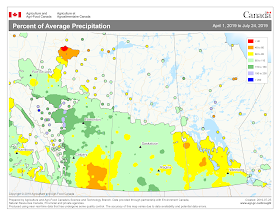Weather synopsis – Prairie temperatures continue to be cooler than average. This past week (July 15-21, 2019), temperatures were approximately 1 °C cooler than last week (Fig. 1). The warmest temperatures were observed across MB while temperatures were cooler in western SK and AB.
 |
| Figure 1. Average temperature (°C) across the Canadian prairies the past seven days (July 15-21, 2019). |
 |
| Figure 2. Average temperature (°C) across the Canadian prairies the past seven days (June 21-July 21, 2019). |
Across the prairies, 30 day (June 21 – July 21, 2019) average temperatures have been approximately 1 °C cooler than normal (Fig. 3). Temperatures were warmest across MB and eastern SK. Growing season temperatures (April 1-July 21, 2019) have been 1 °C cooler than average; the warmest temperatures were observed across the southern prairies.
 |
| Figure 3. Average temperature (°C) across the Canadian prairies for the growing season (April 1-July 21, 2019). |
This past week significant rainfall amounts were reported the parkland region of SK and AB (Fig. 4).
 |
| Figure 4. Cumulative precipitation observed the past seven days across the Canadian prairies (July 15-21, 2019). |
 |
| Figure 5. Cumulative precipitation observed the past 30 days across the Canadian prairies (June 21-July 21, 2019). |
Across the prairies, rainfall amounts for the past 30 days have been highly variable (Fig. 7). Dryer conditions continue across southern AB. Rainfall was well above average in SK. Growing season (April 1 – July 21, 2019) rainfall amounts have been below average across southern regions of AB, and across MB.
 |
| Figure 6. Cumulative precipitation observed the past 30 days across the Canadian prairies (April 1-July 21, 2019). |
 |
| Figure 7. Percent of average precipitation observed across the Canadian prairies for the growing season (April 1-July 24, 2019). Image has not been reproduced in affiliation with, or with the endorsement of the Government of Canada and was retrieved (25Jul2019). Access the full map at http://www.agr.gc.ca/DW-GS/current-actuelles.jspx?lang=eng&jsEnabled=true |
The growing degree day map (GDD) (Base 5 ºC, April 1-July 21, 2019) is below (Fig. 8):
 |
| Figure 8. Growing degree day (Base 5 ºC) across the Canadian prairies for the growing season (April 1-July 21, 2019). |
The growing degree day map (GDD) (Base 10 ºC, April 1-July 21, 2019) is below (Fig. 9):
 |
| Figure 9. Growing degree day (Base 10 ºC) across the Canadian prairies for the growing season (April 1-July 21, 2019). |
The lowest temperatures (°C) observed the past seven days ranged from at least 14 down to at least 2 °C in the map below (Fig. 10).
 |
| Figure 10. Lowest temperatures (°C) observed across the Canadian prairies the past seven days (to July 21, 2019).
Image has not been reproduced in affiliation with, or with the endorsement of the Government of Canada and was retrieved (25Jul2019). Access the full map at http://www.agr.gc.ca/DW-GS/current-actuelles.jspx?lang=eng&jsEnabled=true
|
The highest temperatures (°C) observed the past seven days ranged from less than 16 up to at least 30 °C in the map below (Fig. 11).
 |
| Figure 11. Highest temperatures (°C) observed across the Canadian prairies the past seven days (to July 21, 2019).
Image has not been reproduced in affiliation with, or with the endorsement of the Government of Canada and was retrieved (125ul2019). Access the full map at http://www.agr.gc.ca/DW-GS/current-actuelles.jspx?lang=eng&jsEnabled=true
|
The maps above are all produced by Agriculture and Agri-Food Canada. Growers can bookmark the AAFC Drought Watch Maps for the growing season.